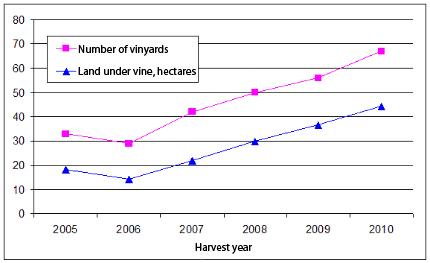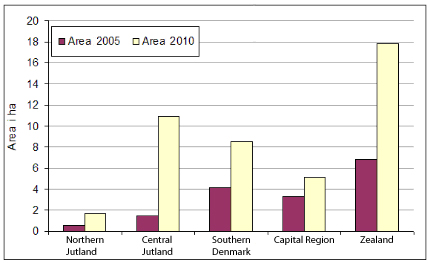The changes in our climate have improved conditions for wine growing in Denmark. Over the past decade, the amount of land under vine in Denmark has doubled due to rising temperatures.
The prerequisite for wine growing is that wine of adequate
quality can be produced in sufficient quantities. The quality of a
wine is determined by a wide range of factors, including the
variety of grape, stock, soil type, climate and cultivation
technique. Traditionally, the production of wine in Europe has been
determined by a combination of soil and climate. These two factors
form the basis for the term "terroir", which indicates the
potential for wine growing in a particular region. Whereas the soil
provides a constant basis for wine production, the weather varies
from year to year and this leads to fluctuations in the quantity
and quality of the wines produced.
Wine production is limited to regions in which the climate is
conducive to growing grapes with a balanced composition of sugar
and acid, which reflects both the region and the variety of grape.
There are three main climatic conditions that must be met in order
to produce wine of high quality:
- low risk of frost damage
- accumulation of sufficient warmth during the summer
- absence of extreme heat
Stocks are resistant to summer drought, provided the soil allows
sufficiently deep root development, and dry weather during
harvesting is an advantage, as it ensures just the right
concentration of sugar and prevents disease in the plants.
Wine's sensitivity to climate change
The global rise in temperature in recent decades has
generally led to an improvement in the quality of wine in Europe.
This is mostly due to rising temperatures during the growing
season, which has affected the quality of the grapes in several
ways. Grapes begin to grow during the spring when the temperature
has been above 10°C for a length of time. The earlier and warmer
the spring, the longer the growing period of the grapes, which
increases the quantity and improves the quality of the wine. High
temperatures during the maturation period result in the formation
of tannins, sugar and flavourings in the grapes. These also improve
the quality of the wine in regions with cool climates.
Development in Danish land under vine from 2005 to
2010
Only grape varieties that are able to withstand cold
winters and can cope with a relatively short and cool summer are
grown in Denmark. However, the warming of the climate has made it
possible to grow grapes in Denmark and achieve both a reasonable
yield and acceptable quality. As a result, the area of land under
vine increased by around 5 hectares a year between 2005 and 2010.
Thus, the area more than doubled during the period (Figure 1).
Similarly, Figure 1 shows that the number of businesses producing
wine also doubled during the period.

Figure 1. Trend in Danish land under vine from 2005 to
2010.
The rise in temperature is also obvious when we look at the
regional trends in land under vine in Denmark. In 2005, 88% of the
land under vine was located in the three southernmost regions
(southern Denmark, the Capital Region of Denmark and Zealand), with
the majority on the island of Zealand (Figure 2). Central Jutland
and northern Jutland accounted for a mere 12% of the land. By 2010,
this figure had risen to 28%. The increase primarily occurred in
central Jutland. However, even the regions that already have wine
production, such as Zealand, are showing a sharp increase in land
under vine, cf. figure 2.

Figure 2. Land under vine between 2005 and 2010, in hectares and
by region.
Chardonnay du Næstved in the future?
Aarhus University has investigated the way in which
growing conditions for the Chardonnay grape will develop in Europe
between now and 2040. Climatic requirements for growing crops are
summarised in a temperature index, which indicates the number of
thermal units that must be accumulated during a growing season for
a crop to reach maturity.
The so-called Huglin Heliothermal Index is used to indicate
whether conditions are suitable for producing wine. Calculations
are based on climate forecasts for 2020 and 2040, produced using
six different climate models.
The area suitable for growing the Chardonnay grape is moving north
in Europe. However, according to the calculations, these grapes
will not be suitable for cultivation in Denmark in 2040. It was
decided here to focus on Chardonnay grapes with a relatively low
heat requirement (1700 Huglin units). A grape such as the Syrah has
a higher heat requirement, 2100 thermal units, and will therefore
be more difficult to grow. However, it is important to emphasise
that all calculations were made based on an average climate in
relatively large areas. This means that, for all crops, there may
be many localities within the areas studied (south-facing slopes
and similar warm pockets) where conditions for growing grapes would
be favourable.